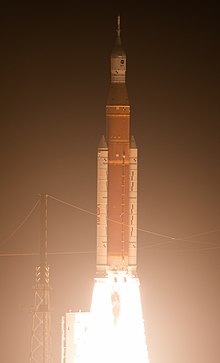
Shuttle-derived vehicles (SDV) are space launch vehicles and spacecraft that use components, technology, and infrastructure originally developed for the Space Shuttle program.[1]
In the late 1980s and early 1990s, NASA formally studied a cargo-only vehicle, Shuttle-C, that would have supplemented the crewed Space Shuttle. In 2005, NASA was developing the Ares I and Ares V launch vehicles, based in part on highly modified Shuttle components, to enable exploration of the Moon and Mars.[2][3] The agency also studied a third such vehicle, the Ares IV.[4]

After the earlier programs were cancelled, NASA began development of the Space Launch System (SLS) in 2011. SLS is a super heavy-lift expendable launch vehicle. Its core stage is structurally and visually similar to the Space Shuttle external tank. Each SLS launch reuses and expends four of the pre-flown RS-25D engines that were de-mounted from the Space shuttles. SLS also uses a pair of solid rocket boosters derived from the Space Shuttle Solid Rocket Booster. The first SLS was delivered to Kennedy Space Center in 2021 for the Artemis 1 mission. As of November 2022[update], this SLS was rolled out to Kennedy Space Center Launch Complex 39B for several attempts to launch, finally launching on 16 November 2022.[5]
- ^ "SDV Presentation" (PDF). Archived from the original (PDF) on 2004-12-21. Retrieved January 29, 2023.
- ^ "Ares: NASA's New Rockets Get Names". NASA. June 30, 2006. Retrieved November 22, 2006.
- ^ Malik, Tariq (30 June 2006). "NASA Names Rockets for Moon and Mars Missions". Space.com. Retrieved 2006-11-22.
- ^ Cite error: The named reference
JPLwas invoked but never defined (see the help page). - ^ "NASA Prepares Rocket, Spacecraft Ahead of Tropical Storm Nicole, Re-targets Launch – Artemis". NASA Blogs. 8 November 2022. Retrieved 9 November 2022.